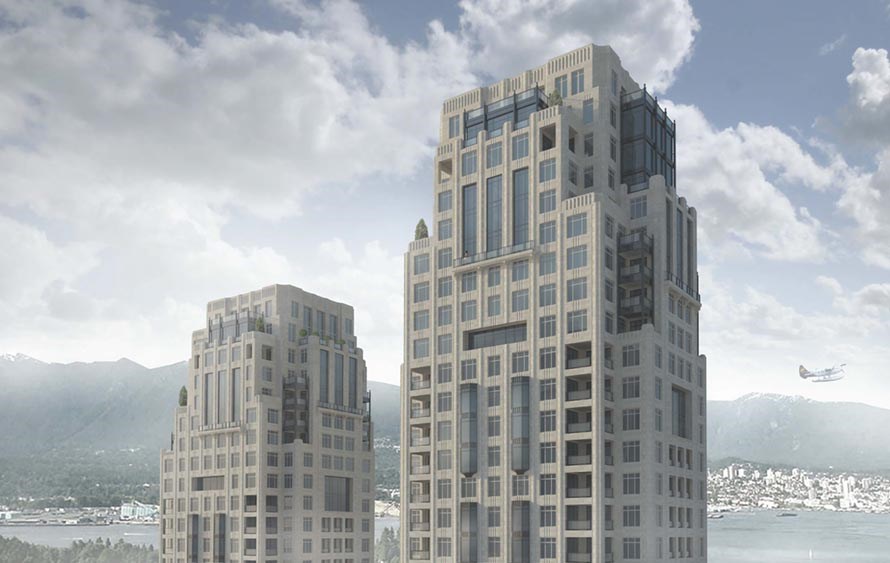It will be a challenge to build the world’s tallest passive-house towers, admits developer Kevin Cheung, who has submitted a rezoning bid for two such highrises in Vancouver’s West End.
Based on requirements developed by Germany’s Passive House Institute, a passive structure must meet rigorous building standards that significantly improve energy efficiency, with up to a 90 per cent reduction in energy use. Theoretically, the standard can be applied to any building type, but in Canada it has so far been restricted to detached houses and low-rise buildings.
If rezoning is successful, Landa Global Properties and Asia Standard Americas will build two condominium towers of 43 and 48 storeys to passive-house standards at 1400 Alberni Street. The tallest passive structure is a twin-tower project with 28 and 31 storeys, located in Bilbao, Spain.
Cheung, CEO of Landa, said the towers would be the first passive-structures the company has ever built. Landa is currently completing three traditional condo towers in Metro Vancouver and is an active developer in Shanghai.
“There are challenges in this new territory,” Cheung said, as it relates to building a highrise to airtight passive standards. Cheung said the towers – designed by New York-based Robert A.M. Stern Architects with Vancouver’s MCM Partnership – uniquely fit Vancouver, which is aiming to have all new building produce zero emissions by 2030 as it vies to become the greenest city on the planet.
Cheung said some building materials, including high-performance windows and special insulation, would initially have to be imported from Europe. Local construction workers would likely require training in passive-house building techniques.
“There will be some extra costs involved,” he said.
The towers could have up to 30 per cent fewer windows than a conventional Vancouver condo tower. The passive-standard insulation levels also require much thicker walls, which would reduce the amount of living space in the tower condos, Cheung said.
He was uncertain whether the towers would have concrete balconies, which allow some heat to escape from a building and are discouraged under the City of Vancouver zero-emissions bylaw that came into effect for all new buildings on May 1.
The new towers will not be equipped for conventional natural gas heating, which is outlawed under the city’s new bylaw. Cheung suggested that some form of ground-source heat pump may be used. The towers would also require mechanical ventilation, which may exhaust into a central storage stack, he said.
“These types of buildings are the future, and we want to be at the cutting edge of that shift,” Cheung said. “While they are more complicated to build, we are looking forward to being pioneers and creating prototypes for a lot of equipment that doesn’t yet exist. We believe we can be leaders in zero-emission building development and design, and pave the way for other projects like this in future.”
To build to Vancouver’s zero-emissions bylaw alone adds an estimated $10,000 to the average cost of a new highrise condo, according to Anne McMullin, president and CEO of the Urban Development Institute, Pacific region. It is expected that building condo towers to passive standard would cost even more, at least initially.
Currently, according to the institute, the selling price of a new highrise condominium in downtown Vancouver ranges from $1,500 to $2,500 per square foot.
Landa’s rezoning application appears to be a slam dunk based on the city’s reaction to its passive-house proposal.
“The city is excited to see industry leaders like Landa Global Properties and Asia Standard take on such an innovative project,” said Gil Kelley, general manager of planning, urban design and sustainability for the City of Vancouver.
“There will be tremendous value for the trades, manufacturers, designers, builders and developers to learn and find innovative solutions to see these towers built to the passive-house standard. And those solutions will translate into better and healthier homes for the families who will occupy them. We hope to have all new buildings produce zero carbon pollution by 2030, and this project will help us realize that goal.”
The Alberni Street site is currently home to an old 128-unit apartment building and an adjacent office building that Landa and Asia Standard bought for $160 million in 2016. Cheung expects to receive rezoning and other city approvals within 18 months and for the world’s tallest passive-house condo towers to open in 2022.



